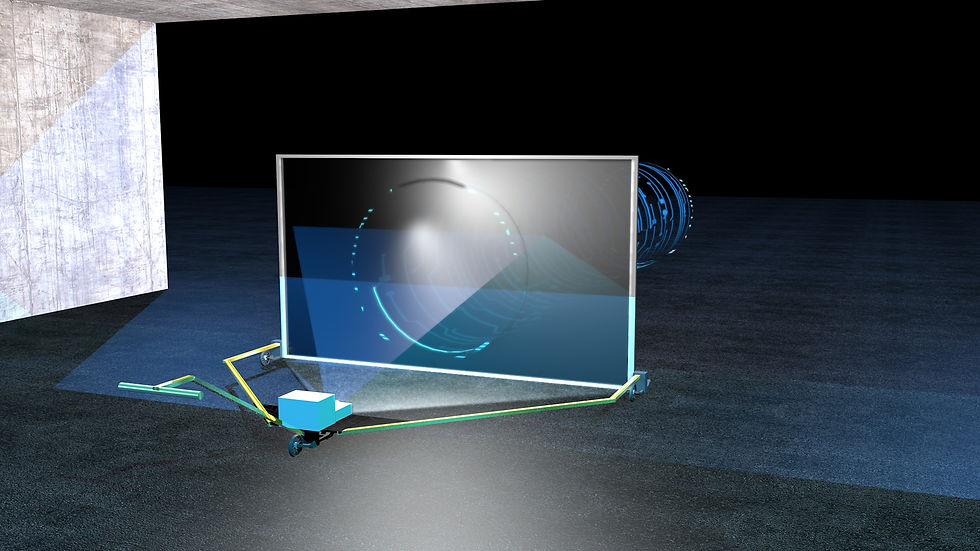
THE HOLOPAINTER
The project with the working title “HOLOPAINTER” provides an artistic discourse on the subject of “Virtual Reality Transfer”. Based on the "Multimorphism" project series, digital Op Art images are transferred into real space using a new technique. The resulting hologram-like image is created by using long-term exposure and enables an interdisciplinary approach that creates a new cross-media interface by combining mapping projection and photography.
Individual images from the series of works are taken as vector data as a basis to be pushed through the camera setup on a rolling canvas.
The combination of mobile mapping projection, slice animation and camera capturing enables the creation of images that merge fiction and reality in real time., bringing an animation as a floating three-dimensional lightpainting in real surroundings to life.
A specially constructed movable backprojection screen is showing a slice scan animation using a short throw projector, which runs through a cross-section animation of an image and creates 3D traces in space through the movement.
Thanks to the mobile substructure, the image can be created in different places and a digital animation series can be captured in real surroundings in photographs and real-time animations.
The resulting new image of different motion designs draws attention to a topic that usually remains hidden in the invisible due to this elaborate artistic staging: "People encapsulate themselves in digital worlds and completely lose the sense of time and the present. With the Holopainter, new possibilities of interaction and immersive art are made possible."
VECTOR OP-ART VISUALIZATION
Depending on the vector model that you take to feed the animationpath, you can visualize different styles in many different ways. In the final stage an evolving animation is creating light trails that only show a specific part at a certain point of the moving screen. (see Concept of Proof Video and images below).
This way I can create a scenario where you take CG graphics from the computer and embed them in real environment. These animations are combined with movement, creating new extruded variants of real-time generated free-floating graphics based on digital data.
THE REALIZATION
I started the first tests back in 2018, adapted to different 3D rendering techniques and tests in 2019, before I started working on the final prototype of the largescale mobile backprojection-technique in the end of 2020. Today the prototype is ready for the first testruns.
This is the first combination of different techniques which leads to outstanding varieties of a single artworks. The so-called terminus multimorphism comes true and allows me to produce endless new variants of one and the same piece of art.
On the screensize of 2.4m x 1.8m, complex 3D renderings can be embedded in real environment. With one and the same artwork, different animation techniques, different driving directions, movements and speed variations can be used to create different abstract variants of each image. In addition to photo series, the real-time capture technology Virtual Ink also enables live recordings in FullHD in which the animated image can build up and break down again depending on the settings.
Das Projekt mit dem Arbeitstitel „HOLOPAINTER“ liefert einen künstlerischen Diskurs zum Thema „Virtual Reality Transfer“.
Basierend auf der Projektreihe "Multimorphism" werden durch eine spezielle Technik digitale Op-Art Bilder in den realen Raum übertragen. Das so erzeugte Hologramm-ähnliche Abbild im Raum entsteht mittels VFX und ermöglicht einen interdisziplinären Ansatz, der durch Kombination von Mapping-Projektion, Kamera aus Animation und Fotografie eine neue crossmediale Echtzeit-Schnittstelle schafft.
Aus der Werkserie werden einzelne Bilder als Vektordaten als Grundlage genommen, um auf einer rollenden Leinwand durch das Setup geschoben zu werden.
Die Kombination aus mobiler Mapping-Projektion, Slice-Animation und Kamera ermöglicht die Erschaffung von Bildern, die Fiktion und Realität in Echtzeit miteinander verschmelzen lassen.
Eine eigens konstruierte bewegbare Leinwand wird mittels Shortthrow-Beamer mit einer Slice-Scan-Animation bespielt, die eine Querschnittsanimation eines Blldes durchläuft und durch die Bewegung ein 3D-Abbild im Raum erzeugt. Das so entstandene neue Abbild von unterschiedlichen Motion Designs lenkt die Aufmerksamkeit auf ein Thema, das durch diese aufwändige künstlerische Inszenierung normalerweise im Unsichtbaren verborgen bleibt:
„Menschen kapseln sich in digitale Welten ein und verlieren völlig das Zeit- und Gegenwartsgefühl. Mit dem Holopainter öffnen sich neu Möglichkeiten zwischen Interaktion und Kunst“.
VECTOR OP-ART VISUALISIERUNG
Abhängig von dem Vektormodell, das verwendet wird, um die Animation zu erstellen, können verschiedene Animations-Stile aus einer Grafik erstellt werden. In der finalen Umsetzung entstehen so Lichtspuren, die einen bestimmten Teil der Animation an einem bestimmten Punkt des sich bewegenden Bildschirms zeigen.
Auf diese Weise kann ich ein Szenario erstellen, in dem man CG-Grafiken aus dem Rechner holt und in reale Umgebung einbettet . Diese Animationen werden mit Bewegung kombiniert und erzeugen neue extrudierte Varianten von Echtzeit-generierten frei im Raum schwebende Grafiken, die basierend auf digitalen Daten erzeugt werden.
DIE UMSETZUNG
2018 begann ich mit den ersten Tests, 2019 gefolgt von Experimenten verschiedener 3D-Rendering Methoden. Seit Ende 2020 arbeite ich am Prototypen für die finale und in groß angelegte mobile Rückprojektions-Technik. Heute ist der Prototyp bereit für den ersten Testlauf. Mit einer Fläche von 2,4m Breite und 1,8m Höhe ist die Darstellung von komplexen 3D-Renderings in realer Umgebung möglich. Gearbeitet wird mit einem Rückprojektions-Screen auf Rollen, der sich im Set von der Kamera weg bewegt. Während dieser Bewegung wird auf dem Screen eine dreidimensionale Slice-Animation abgespielt, die ein dreidimensionales Abbild im Bild erzeugt.
Durch die Verbindung von sich bewegender Leinwand und statischer Kamera-Perspektive kann individueller MR Content produziert werden. Im finalen Bild entsteht dadurch eine Fusion aus realer Umgebung und eingebettetem schwebenden digitalem Content.
Mit ein und derselben Animation lassen sich durch unterschiedliche Fahrtrichtungen, Bewegungen und Geschwindigkeitsvariationen verschiedene abstrakte Varianten eines Bildes erzeugen.cMit der Virtual Ink Realtime-Capture-Technik ermöglicht neben Fotoserien auch Live-Aufnahmen in FullHD, bei denen sich das animierte Bild je nach Einstellungen auf- und wieder abbauen kann.
GALLERY



































